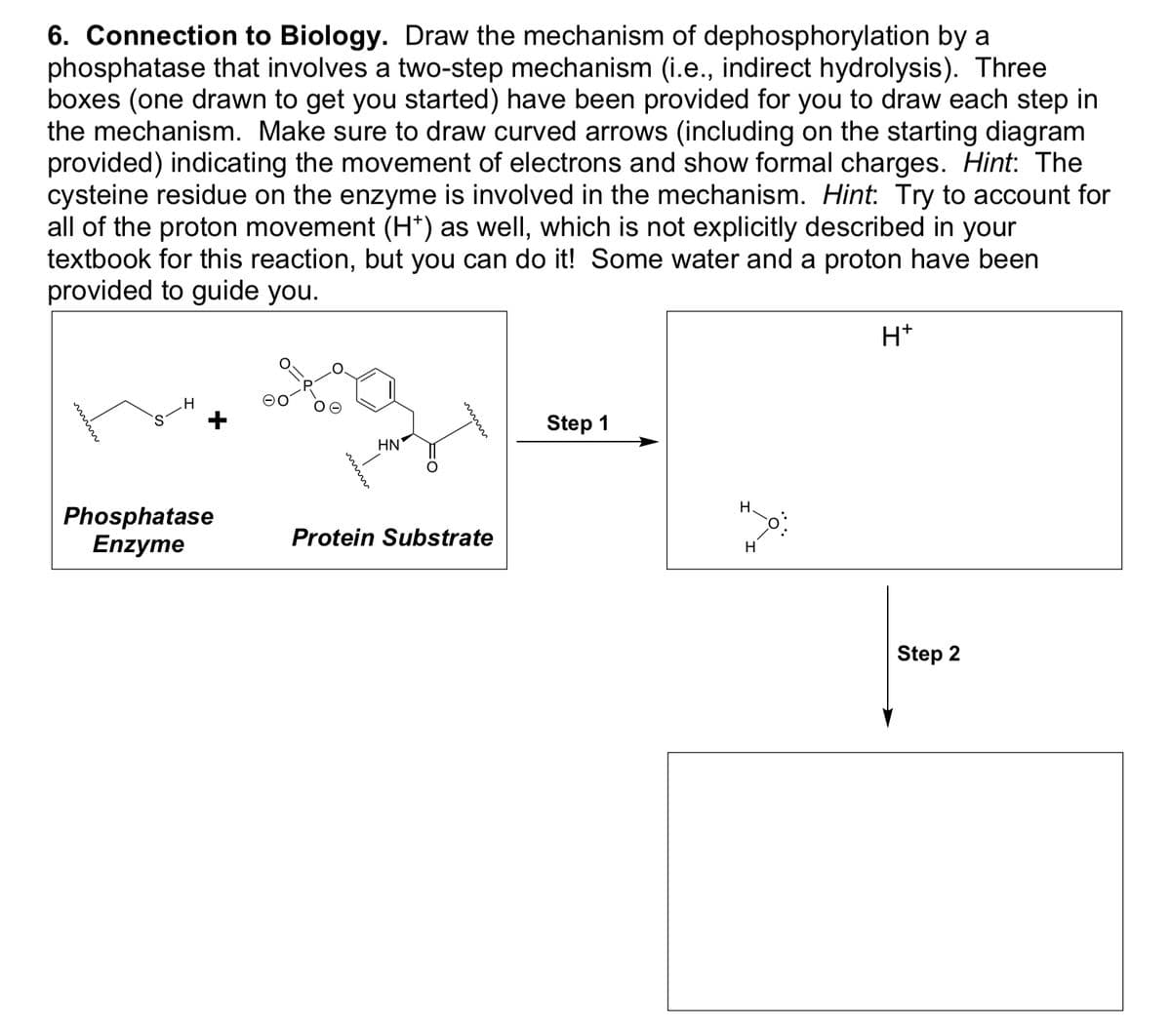6. Connection to Biology. Draw the mechanism of dephosphorylation by a phosphatase that involves a two-step mechanism (i.e., indirect hydrolysis). Three boxes (one drawn to get you started) have been provided for you to draw each step in the mechanism. Make sure to draw curved arrows (including on the starting diagram provided) indicating the movement of electrons and show formal charges. Hint: The cysteine residue on the enzyme is involved in the mechanism. Hint: Try to account for all of the proton movement (H+) as well, which is not explicitly described in your textbook for this reaction, but you can do it! Some water and a proton have been provided to guide you. H Step 1 HN Phosphatase Enzyme Protein Substrate H. H H+ Step 2
6. Connection to Biology. Draw the mechanism of dephosphorylation by a phosphatase that involves a two-step mechanism (i.e., indirect hydrolysis). Three boxes (one drawn to get you started) have been provided for you to draw each step in the mechanism. Make sure to draw curved arrows (including on the starting diagram provided) indicating the movement of electrons and show formal charges. Hint: The cysteine residue on the enzyme is involved in the mechanism. Hint: Try to account for all of the proton movement (H+) as well, which is not explicitly described in your textbook for this reaction, but you can do it! Some water and a proton have been provided to guide you. H Step 1 HN Phosphatase Enzyme Protein Substrate H. H H+ Step 2
Chapter21: Carboxylic Acid Derivatives: Nucleophilic Acyl Substitution Reactions
Section21.SE: Something Extra
Problem 42MP
Related questions
Question

Transcribed Image Text:6. Connection to Biology. Draw the mechanism of dephosphorylation by a
phosphatase that involves a two-step mechanism (i.e., indirect hydrolysis). Three
boxes (one drawn to get you started) have been provided for you to draw each step in
the mechanism. Make sure to draw curved arrows (including on the starting diagram
provided) indicating the movement of electrons and show formal charges. Hint: The
cysteine residue on the enzyme is involved in the mechanism. Hint: Try to account for
all of the proton movement (H+) as well, which is not explicitly described in your
textbook for this reaction, but you can do it! Some water and a proton have been
provided to guide you.
H
Step 1
HN
Phosphatase
Enzyme
Protein Substrate
H.
H
H+
Step 2
AI-Generated Solution
Unlock instant AI solutions
Tap the button
to generate a solution
Recommended textbooks for you


Organic Chemistry: A Guided Inquiry
Chemistry
ISBN:
9780618974122
Author:
Andrei Straumanis
Publisher:
Cengage Learning

EBK A SMALL SCALE APPROACH TO ORGANIC L
Chemistry
ISBN:
9781305446021
Author:
Lampman
Publisher:
CENGAGE LEARNING - CONSIGNMENT


Organic Chemistry: A Guided Inquiry
Chemistry
ISBN:
9780618974122
Author:
Andrei Straumanis
Publisher:
Cengage Learning

EBK A SMALL SCALE APPROACH TO ORGANIC L
Chemistry
ISBN:
9781305446021
Author:
Lampman
Publisher:
CENGAGE LEARNING - CONSIGNMENT